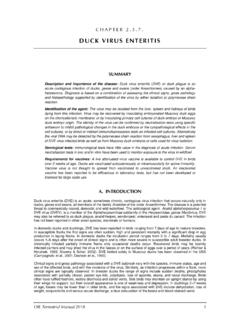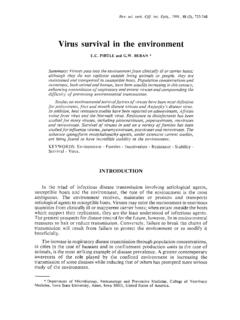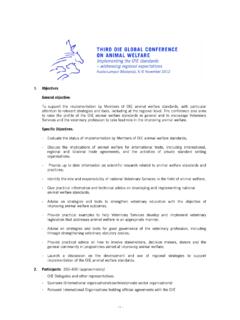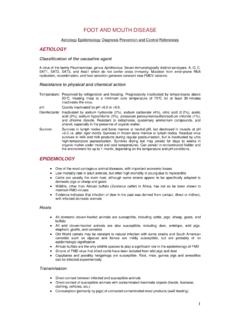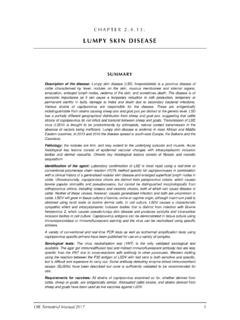Transcription of Infection with ranavirus - Home: OIE
1 _____OIE Aquatic Animal Disease Cards, 2007 Infection with ranavirus P A T H O G E N I N F O R M A T I O N 1. CAUSATIVE AGENT Pathogen type Virus. Disease name and synonyms Infection with ranavirus . No specific synonyms, but the terms ranavirosis, ranavirus disease or ranaviral disease can be used. Pathogen common name and synonyms Members of the genus ranavirus , including: Frog Virus 3 (FV-3) (synonyms: Box turtle virus 3; Bufo United Kingdom virus- BUK; Bufo marinus Venezuelan iridovirus 1; Luck triturus virus 1; Rana United Kingdom virus RUK; Redwood Park virus; Stickleback virus; Tadpole edema vi-rus TEV; Tadpole virus 2; Tiger frog virus - TFV; Tortoise virus 5). Ambystoma tigrinum virus (ATV) (synonym: Regina ranavirus ). Bohle iridovirus (BIV). Santee-Cooper ranavirus (SSRV) (synonyms: Doctor fish virus DFV; Guppy virus 6 GV6; Largemouth bass virus LMBV). Rana esculenta iridovirus Singapore grouper iridovirus Testudo iridovirus Taxonomic affiliation Pathogen scientific name (Genus, species, sub-species or type) Virus species within the genus ranavirus except Epizootic Haematopoietic Necrosis Virus (EHNV) and European Catfish Virus (ECV) (synonyms: European sheatfish virus ESV; Ictalurus melas ravanirus).
2 Phylum, class, family, etc. ranavirus is a genus within the family Iridoviridae Description of the pathogen Large (120 to 300 nm diameter), icosahedral, linear double stranded DNA viruses. The ranavirus genome, which is typically 100-210 kbp in size, is circularly permuted and terminally redundant. Virus particles may be enveloped (obtained from the plasma membrane) or unenveloped; replicates in the cytoplasm or nucleus. Authority (first scientific description, reference) Granoff, A., Came, P. E. and Breeze, D. C. (1966) Viruses and renal carcinoma of Rana pipiens. I. The isolation and properties of virus from normal and tumor tissue. Virology, 29, 133-148. Pathogen environment (fresh, brackish, marine waters) Fresh water. 2. MODES OF TRANSMISSION Routes of transmission (horizontal, vertical, direct, indirect) Horizontal, via contaminated water, per os (cannibalism).
3 Vertical transmission is considered likely, but has not been experimentally documented. Life cycle Not applicable. Associated factors (temperature salinity, etc.) Seasonal variations in the prevalence or severity of disease outbreaks have been reported, with both being greater during the warmer months, therefore temperature is considered a likely factor influencing disease outbreaks, but no experimental data is available. Additional comments None. 3. HOST RANGE Host type Amphibians (all members of the class Amphibia are considered to be susceptible). Infection also can occur in fish and reptiles with fatal consequences. Host scientific names Amphibia. Other known or suspected hosts Fish and reptiles. Affected life stage All life stages have been shown to be susceptible. Additional comments None. 4. GEOGRAPHICAL DISTRIBUTION Region Americas, Asia and Pacific, Europe. Countries _____OIE: 12 rue de Prony, 75017 Paris, France - Tel.
4 33 (0) - Fax: 33 (0) E-mail: - 2 Known presence in Canada, USA, Venezuela, Australia, China, United Kingdom and Croatia. D I S E A S E I N F O R M A T I O N 5. CLINICAL SIGNS AND CASE DESCRIPTION Host tissues and infected organs Infection has been demonstrated in all major tissues except for striated (skeletal) muscle, smooth muscle and cardiac muscle. However, virus can be isolated from skeletal muscle, probably from blood in tissues. Gross observations and macroscopic lesions The most common presentation is an explosive mortality event with death due to peracute systemic haemorrhagic disease. In these cases, usually there are no external lesions. Skin vesicles have been reported with ATV Infection in tiger salamanders (Ambystoma tigrinum). A chronic ranavirus disease, characterised by skin ulceration and necrosis of the distal limbs, has been reported from the United Kingdom.
5 Microscopic lesions and tissue abnormality In haematoxylin and eosin stained sections of skin, epithelial hyperplasia with disruption of the normal stratified architecture of the epidermis and often with necrosis of the deeper epithelial layers has been reported. Multiple foci of necrosis can be found in tissues, but these are rare in cases of the skin ulcerative form of disease. These necrotic foci are most obvious in the renal and splenic haematopoietic tissue and in the liver. Intracytoplasmic virus inclusions have been reported in a variety of tissues, most obviously in hepatocytes. OIE status Listed under Article of the Aquatic Code 6. SOCIAL AND ECONOMIC SIGNIFICANCE Considered to be of some economic importance due to disease and mortalities in farmed Lithobates catesbeianus (formerly Rana catesbeiana) and harvested Rana esculenta. Potential economic losses due to potential risk of disease spread to fish.
6 Social consequences of the disease are high where large-scale disease outbreaks occur in wild amphibians, such as in the United Kingdom and North America. 7. ZOONOTIC IMPORTANCE None. 8. DIAGNOSTIC METHODS Virus culture followed by identification using electron microscopy and/or PCR. Electron microscopical or PCR examination of diseased tissues can also be used. Surveillance methods PCR to detect DNA coding for the major capsid protein, as described by Hyatt et al. (2000).. Presumptive methods The occurrence of an explosive mortality outbreak with consistent gross signs of systemic haemorrhagic disease, or signs of chronic disease with skin ulceration and/or distal limb necrosis are potential indicators of Infection . In haematoxylin and eosin stained histological sections: the presence of epidermal hyperplasia with necrosis and/or foci of necrosis within the renal and/or splenic haematopoietic tissue and/or liver with /without the presence of intracytoplasmic inclusions within hepatocytes.
7 Confirmatory methods Examination of diseased tissues by electron microscopy for evidence of mature virions in the cytoplasm of infected cells can assist confirmatory diagnosis. It is recommended that PCR to detect DNA coding for the major capsid protein (which is highly conserved between ranavirus species) be used for confirmatory diagnosis. Methods for electron microscopy and PCR are described by Hyatt et al. (2000). Immunohistochemistry can also be used as a confirmatory test. The method for immunohistochemistry is described by Reddacliff & Whittington (1996). 9. CONTROL METHODS No known methods of prevention or control. The use of specific pathogen-free (SPF) stocks under biosecure conditions is the recommended method for prevention of ranavirus disease in amphibian farms. Infected amphibians should not be transported into areas known to be free of ranavirus .
8 A 4% concentration of sodium hypochlorite can be used to disinfect premises and fomites; ozone treatment can be used to sterilise water (Miocevic et al. 1993). S E L E C T E D R E F E R E N C E S Bollinger, T. K., Mao, J. H., Schock, D., Brigham, R. M. & Chinchar, V. G. (1999) Pathology, isolation, and preliminary molecular characterization of a novel iridovirus from tiger salamanders in Saskatchewan. Journal of Wildlife Diseases 35, 413-429. Cunningham, A. A., Langton, T. E. S., Bennett, P. M., Lewin, J. F., Drury, S. E. N., Gough, R. E. & MacGregor, S. K. (1996) Pathological and microbiological findings from incidents of unusual mortality of the common frog (Rana temporaria). Philosophical Transactions of the Royal Society of London - Biological Sciences, 351, 1539-1557. Cunningham, A. A., Hyatt, A. D., Russell, P. & Bennett, P. M. (2007) Emerging epidemic diseases of frogs in Britain are dependent on the source of ranavirus agent and the route of exposure.
9 Epidemiology & Infection in press. Cunningham, A. A., Tems, C. A. & Russell, P. H. Immu-nohistochemical demonstration of ranavirus antigen in the tissues of infected frogs (Rana temporaria) with systemic _____OIE: 12 rue de Prony, 75017 Paris, France - Tel. 33 (0) - Fax: 33 (0) E-mail: - 3 haemorrhagic or cutaneous ulcerative disease. Journal of Comparative Pathology in press. Hyatt, A. D., Gould, A. R., Zupanovic, Z., Cunningham, A. A., Hengstberger, S., Whittington, R. J., Coupar, B. E. H. (2000) Characterisation of piscine and amphibian iridovi-ruses. Archives of Virology 145, 301-331. Mao, J., Green, D. E., Fellers, G. & Chinchar, V. G. (1999) Molecular characterization of iridoviruses isolated from sympatric amphibians and fish. Virus Research 63, 45-52. Jancovich, J. K., Davidson, E. W., Morado, J. F., Jacobs, B. L. & Collins, J. P. (1997) Isolation of a lethal virus from the endangered tiger salamander Ambystoma tigrinum stebbinsi.
10 Diseases of Aquatic Organisms 31, 161-167. Miocevic, I., Smith, J., Owens, L. and Speare, R. Ultravio-let sterilisation of model viruses important to finfish aqua-culture in Australia. Australian Veterinary Journal 1993;70:25-27. Reddacliff, L. A. & Whittington, R. J. (1996) Pathology of epizootic haematopoietic necrosis virus (EHNV) Infection in rainbow trout (Oncorhynchus mykiss Walbaum) and redfin perch (Perca fluviatilis L.). Journal of Comparative Pathology 115, 103-115. OIE Reference Experts and Laboratories in 2007

